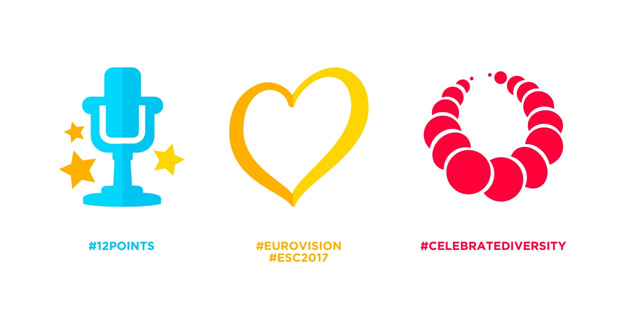👨🎤🎶👩🎤Eurovision Emojis Collection
Interesting Facts:
- Three Eurovision-related emojis were created and uploaded to Twitter in 2017. You can find them using the following hashtags: # 12POINTS, #EVROVISION, # ESC2017, #CELEBRATEDIVERSITY.

- In 2018, a Video in the emoji challenge format was released on YouTube on their official Eurovision channel. Users there are invited to guess the contest songs of different years by emojis. In 2020, the official Eurovision Twitter account published a Post with an emoji quiz, where users are also asked to guess popular songs by emojis from past Eurovision contests.
The 👨🎤🎶👩🎤 Eurovision Emojis Collection page provides the following information:
1. History of the 👨🎤🎶👩🎤 Eurovision
In the early 1950s, the members of the European Broadcasting Union (EBU) decided to create an unusual and entertaining program that would help to 🤝 Unite various European countries after the end of World War II. It was the head of the EBU, Marcel Besançon, who put forward the idea of creating an international 🗣 Song contest, the prototype of which was the 🇮🇹 Italian 🎶 Music 🎉 Festival in San Remo. On October 19, 1955, his idea was approved at the General Assembly of the EMU.
The first competition was held in 🇨🇭 Switzerland on May 24, 1956, under the name Eurovision Grand Prix. 7 countries took part in it, each of which presented two songs. The conditions of the competition changed further, and the participating countries could present only one contest song. The first 🏆 Winner of the festival was the performer 👩🎤 Liz Assia from Switzerland with the song “Refrain”.
Every year the number of participating countries has been growing, so in 2004 the competition was divided into a semi-final and a final, and in 2008 it was divided into two semi-finals and a final.
Interesting facts:
- According to statistics, the best participating country is 🇮🇪 Ireland, whose representatives have won 7 times, with 3 times in a row. The 🥈 2nd place goes to 🇸🇪 Sweden with 6 wins, and the 🥉 3rd place goes to 🇬🇧 Great Britain with 5 wins;
- At the beginning and the end of the Eurovision broadcast, there is a prelude to Te Deum by Marc Antoine Charpentier.
Examples of using
Tap / click to copy & paste
Combinations
Tap / click to copy
Collection
2. Traditions and symbols of the 👨🎤🎶👩🎤 Eurovision contest
The main symbol of the event is the Eurovision logo: a handwritten inscription “Eurovision”, where instead of the letter “v” there is a 🤍 Heart, which displays the flag of the host country.
Traditionally, each contest has been held under a specific motto since 2002, except for Eurovision 2009, when each country had its theme. For example, in 2012 the motto was “Light your 🔥 Fire”, and in 2019 “Dare to 😌 Dream”.
Interesting fact: According to the Eurovision rules, a contest song should not exceed 3 minutes in length, and the maximum number of 👯 Performers” mustn’t be more than 6 people on stage.
Examples of using
Tap / click to copy & paste
Combinations
Tap / click to copy


